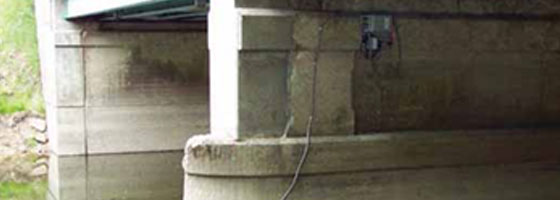Bridge scour monitoring project funded by Michigan Department of Transportation

Proper bridge design depends on many factors. One factor is a proper estimate of expected scour around the bridge piers and abutments. Local accelerations of the river as it passes through a constricted bridge opening causes scour, and the design of the bridge must account for it. Due to the complexity of the physical processes at work in the vicinity of bridge piers, scour prediction models contain a large amount of uncertainty. Uncertainty is generally accounted for by over-predicting expected scour depth to ensure the safety of the bridge. While over estimating scour depth is necessary for safety, it increases the cost of bridge construction.
In an effort to reduce uncertainty associated with scour prediction models, the Michigan Department of Transportation awarded a research grant to Wayne State University and Lawrence Technological University to collect field-scale data related to pier scour. Reducing uncertainty will help reduce the cost of bridge construction without sacrificing safety.

Bridge-mounted data logger
System Description
The research team chose their initial site along the Flint River in mid-Michigan. Soil and bridge characteristics as well as presence of USGS real-time flow gauge influenced site selection. A Tritech Micron Echo Sounder was mounted at the site to measure the depth to the riverbed, and a NexSens AccuStage vented pressure transducer was selected to measure the changes in water level.
Both instruments were placed inside a 1.5 PVC tube with a 90-degree bend, and the PVC housing was installed on the bridge pier with the elbow resting on top of the spread footing to prevent vertical movement. The AccuStage pressure transducer was installed to the depth of the footing, while the Micro Sounder was cantilevered over the footing to measure the depth to the riverbed. Cabling for both instruments runs through the top of the PVC housing and into a NexSens 3100-iSIC data logger with cellular telemetry.
The Micron Echo Sounder requires more power than the standard 8.5 A-Hr iSIC battery can supply. To compensate, an external 55 A-Hr marine battery is mounted on top of the pier between the steel beams to power the system. A uni-strut frame anchors the 3100iSIC data logger to the top of the bridge pier. A NexSens A23 30-watt solar panel provides a continuous charge to the marine battery to keep the system powered without the need to continuously swap batteries.
Bridge scour data is collected once per hour and transmitted via cellular telemetry back to the project computer running iChart Software. The results are stored on a network storage device shared between the universities and project sponsor.
For more information, please call 888.426.2151 or email customercare@fondriest.com.




0 comments